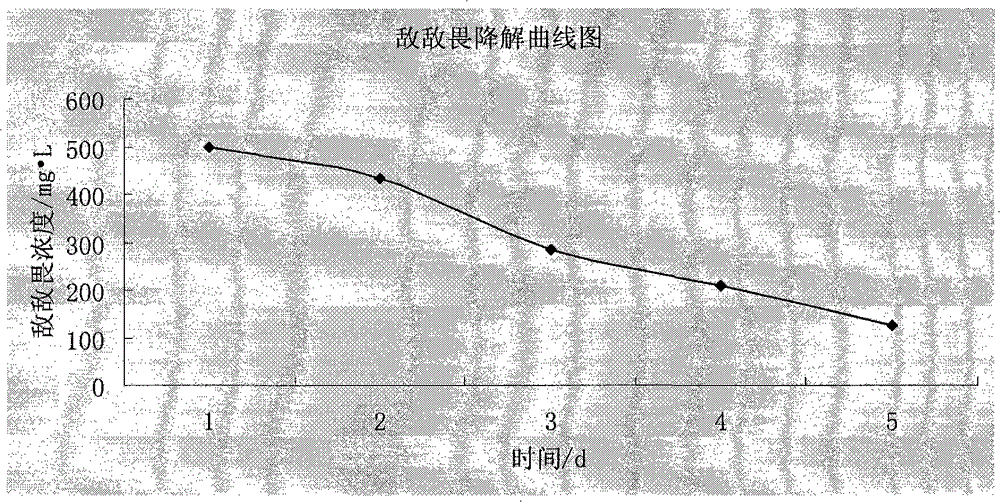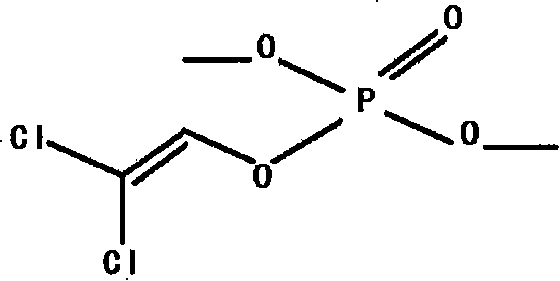Screening method of degrading bacteria strains by taking DDVP as substrate
A screening method, the technology of dichlorvos, is applied in the field of screening of degrading strains, which can solve the problems of high price and secondary pollution of chemical treatment methods, and achieve the effect of simple screening method, good effect and good application potential
- Summary
- Abstract
- Description
- Claims
- Application Information
AI Technical Summary
Problems solved by technology
Method used
Image
Examples
Embodiment 1
[0019] Screening of dichlorvos-degrading strains:
[0020] 1) Bacteria sample collection: collected from soil samples polluted by dichlorvos pesticides for a long time near Sujiatun Pesticide Factory in Shenyang City.
[0021] 2) Enrichment and domestication of degrading bacteria: Inoculate 2g of bacterial samples into 100ml enrichment medium containing dichlorvos and mix well for transfer culture. 1 day, a total of 4 transfers, the transfer amount was calculated by volume percentage, and 10% of each culture solution was inoculated in 100ml enrichment medium containing dichlorvos gradually increasing for use; wherein dichlorvos was gradually increased by 100mg / L each time, 4 times During the transfer process, the dichlorvos were 100, 200, 300, 400mg / L respectively.
[0022] The enrichment medium in the step 1) consists of: MgSO 4 ·7H 2 O 0.20g, (NH4) 2 SO 4 0.50g, KH 2 PO 4 0.50g, NaCl 1.0g, K 2 HPO 4 1.50g, dichlorvos 100mg respectively, add distilled water to 100...
Embodiment 2
[0026] Determination of degradative strain degradative activity:
[0027] 1) Pretreatment of the sample: take 4mL of the solution to be tested, centrifuge at 5000r / min for 8 minutes, take the supernatant, add 8mL of acetone, shake vigorously; then add 4g saturated sodium chloride and shake vigorously for 1min, and let it stand for 5min at room temperature to make The water phase and the acetone phase are separated, the upper layer of acetone is removed, and the upper layer of acetone is passed through an anhydrous sodium sulfate column at normal temperature and pressure to collect the outflowing acetone for gas chromatography determination.
[0028] 2) Determination of degradation rate: The acetone collected above was subjected to gas chromatographic determination, and the gas chromatographic conditions were: NPD detector; DB-1701P chromatographic column (30m×0.32mm×0.25μm); oxygen flow rate 60mL / min, hydrogen flow rate 2.3 mL / min, nitrogen flow rate 1.2ml / min, detector temper...
Embodiment 3
[0032] The difference from Example 1 is:
[0033]1) Enrichment and acclimatization of degrading bacteria: Inoculate 3g of bacterial samples into 120mL enrichment medium containing dichlorvos for transfer culture. Connect 5 times, the amount of transfer is calculated by volume percentage, and 8% of each culture solution is inoculated in the 120ml enrichment medium containing dichlorvos gradually increasing for use; wherein the first addition of dichlorvos is 150mg / L, and then gradually increased by 150mg / L, During the 5 transfers, the dichlorvos levels were 150, 300, 450, 600, and 750 mg / L respectively.
[0034] 2) Separation and screening: take the acclimatization liquid cultured in step 1) and dilute it by 10 5 Afterwards, spread on the beef extract peptone solid plate, and invert at 32°C for 3-4 days;
[0035] 3) Re-screening of degrading bacteria: the strains grown in step 2) were separated by streaking on a solid plate of selective inorganic salt medium containing dichlo...
PUM
 Login to View More
Login to View More Abstract
Description
Claims
Application Information
 Login to View More
Login to View More - R&D
- Intellectual Property
- Life Sciences
- Materials
- Tech Scout
- Unparalleled Data Quality
- Higher Quality Content
- 60% Fewer Hallucinations
Browse by: Latest US Patents, China's latest patents, Technical Efficacy Thesaurus, Application Domain, Technology Topic, Popular Technical Reports.
© 2025 PatSnap. All rights reserved.Legal|Privacy policy|Modern Slavery Act Transparency Statement|Sitemap|About US| Contact US: help@patsnap.com


